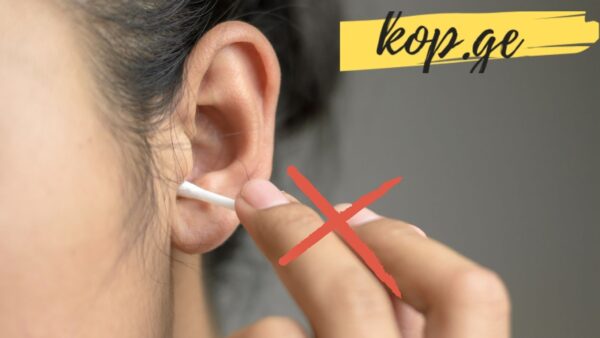How to Clean Your Ears Properly and Safely

Earwax, also known as cerumen, is a natural substance produced by the glands in the ear canal. It plays an essential role in protecting the ears from dust, harmful microorganisms, and foreign particles. Additionally, it acts as a natural lubricant, keeping the ear canal moist and preventing irritation and dryness.
However, while earwax is beneficial in small amounts, buildup can become a problem. When it accumulates excessively, it can cause discomfort, muffled hearing, dizziness, irritation, itching, or even temporary hearing loss. In some cases, it may feel like your ear is “blocked” or full.
To avoid such complications, it’s important to learn how to clean your ears correctly and safely, without damaging the delicate inner structures or pushing the wax deeper into the canal.
What Causes Excessive Earwax Buildup?
One of the most common causes of earwax blockage is the use of cotton swabs (Q-tips). While many people use them for ear cleaning, they can actually push the wax deeper into the ear canal, compacting it and making it harder to remove.
Other contributing factors include:
Wearing earbuds or hearing aids regularly
Narrow ear canals or excessive hair in the ears
Skin conditions that affect the ear canal (e.g., eczema)
Overproduction of wax by the glands
Symptoms of Excess Earwax Buildup
If you experience one or more of the following symptoms, it might be a sign that your ears are blocked with wax:
Itching in the ear canal
A fullness or pressure in the ear
Dizziness or imbalance
Tinnitus (ringing in the ears)
Reduced hearing in one or both ears
Ear pain or discomfort
Safe and Effective Methods to Clean Your Ears at Home
Here are several natural and safe methods you can use at home to help dissolve or soften earwax without risking damage to your ears:
1. Saltwater Solution
A simple saline solution can help loosen hardened earwax and make it easier to drain out.
How to use:
Dissolve 1 teaspoon of salt in ½ cup (100 ml) of warm water.
Soak a cotton ball in the solution and gently squeeze a few drops into your ear while tilting your head to the side.
Hold that position for a few minutes to let the liquid penetrate.
Then tilt your head to the opposite side and let the fluid drain out.
Gently wipe your outer ear with a clean cloth or tissue.
2. Paraffin Oil
Paraffin oil is one of the safest and most effective remedies for softening and removing earwax.
How to use:
Warm 2–3 tablespoons of paraffin oil using a candle flame or warm water bath. Make sure it’s warm, not hot.
Using a dropper, put a few drops into your ear.
Let it sit for about 5 minutes, keeping your head tilted.
Rinse with warm water afterward to flush out loosened wax.
Repeat this process for 3 consecutive days to dissolve wax buildup fully.
3. Hydrogen Peroxide (3%)
Hydrogen peroxide is another common household item that can help with earwax removal.
How to use:
Mix equal parts hydrogen peroxide (3%) and clean water.
Use a dropper to place a few drops into your ear.
Keep your head tilted to allow the solution to bubble and break down the wax.
After 3–5 minutes, tilt your head the other way to let the mixture drain out.
Wipe clean with a soft cloth.
⚠️ Always use 3% hydrogen peroxide or lower. Stronger concentrations can damage the ear canal.
4. Glycerin
Glycerin is a natural moisturizer that also helps soften earwax effectively.
How to use:
Put 3–4 drops of glycerin into each ear up to three times a day.
Let it sit for a few minutes before tilting your head to drain it out.
Use regularly for a few days to see the best results.
5. Vinegar and Alcohol Solution
A combination of white vinegar and rubbing alcohol can help disinfect the ear and dissolve wax.
How to use:
Mix equal parts of white vinegar and rubbing alcohol in a small bowl.
Soak a cotton ball or use a dropper to place a few drops in each ear.
Let it sit briefly, then tilt your head to allow the liquid to flow out.
Repeat as needed every few days.
6. Olive Oil
Olive oil is a gentle, widely used remedy that helps to soften wax so it can exit the ear naturally.
How to use:
Warm the oil slightly (not hot).
Put 2–3 drops into the affected ear at bedtime.
Sleep on the opposite side so the oil stays in place overnight.
Repeat for 3–4 consecutive nights to allow the wax to soften and exit naturally.
⚠️ Important Warnings and When to See a Doctor
While these home remedies are generally safe, there are times when professional medical help is necessary. Avoid self-cleaning if:
You have pain, discharge, or bleeding from the ear
You’ve had ear surgery or a punctured eardrum
You’re experiencing severe hearing loss
Home remedies haven’t helped after several days
Never use sharp objects, cotton swabs, or other foreign tools to dig into your ears. These can push wax deeper, cause injury, or even lead to infection.
Final Thoughts
Proper ear hygiene is essential, but it must be done gently and with care. Overcleaning your ears can do more harm than good, stripping away the protective wax and increasing the risk of infections.
Instead of relying on cotton swabs or risky tools, consider these natural remedies to help manage and remove excess earwax safely. Just a few drops of the right solution can make a big difference in your ear health, hearing clarity, and overall comfort.
And always remember: if you’re in doubt, or if symptoms persist, it’s best to consult a healthcare professional.
Healthy ears = better hearing and better balance. Take care of them naturally and wisely.












